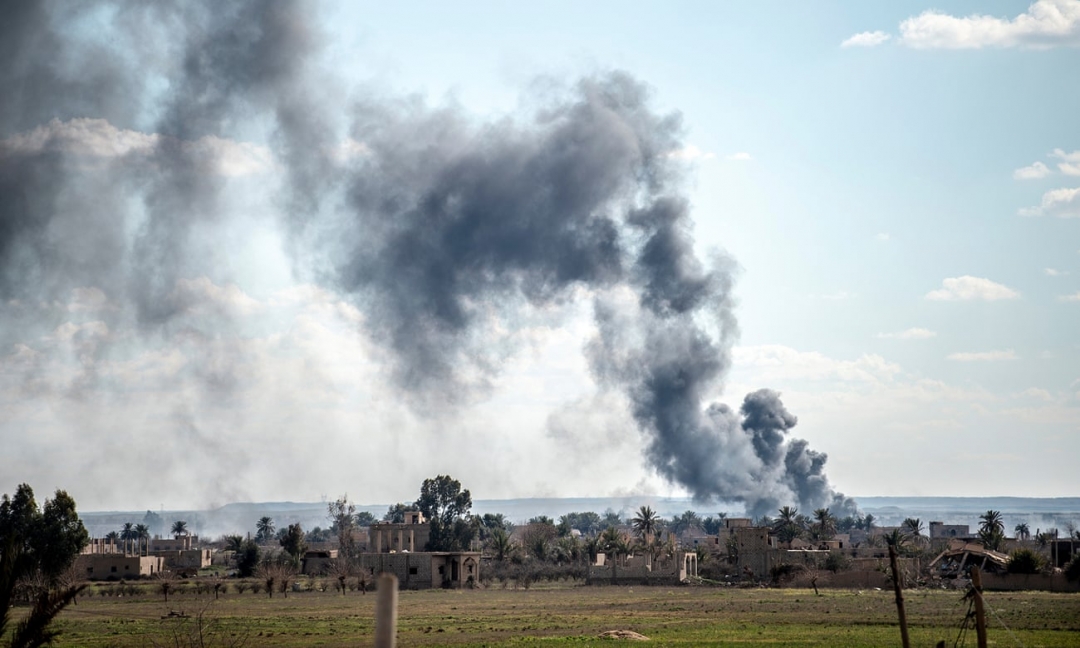The caliphate is a hellscape of smoke and fire – Isis has nowhere left to go

There is a flash of light in the dark town as an airstrike hits an Islamic State weapons depot. A few seconds later, a ball of flame engulfs the entire neighbourhood. The sonic boom sends shockwaves through Baghuz, shaking the ground miles away, and for a second everything and everyone is stunned into silence. Then the artillery fire starts up again.
Five years after Isis swept across Syria and Iraq, all that remains of the “caliphate” that at its peak stretched across two countries and controlled 10 million people is a handful of streets in a bend of the Euphrates river running through this desert town, which will be retaken in the next few days.
Trapped from the east and the west by advancing Kurdish-led Syrian Democratic Forces (SDF) and by the Syrian regime and Russia on the other side of the river, the caliphate is a hellscape of smoke and fire. There is nowhere left for the fighters to go.
The US-led coalition is making up for lost time in the fight to drive Isis out of its last stronghold. After a 10-day truce to evacuate women and children from the town, the offensive restarted this weekend at a tempo not seen even in the major battles for the cities of Mosul and Raqqa.
Isis snipers, suicide bombs and heat-seeking rockets are preventing the SDF from making gains on the ground during daylight. But when darkness falls, Isis is hampered without night vision goggles, and for the past two nights US jets and helicopters have attacked. At least 160 machine guns are stationed at 50-metre intervals along the frontline, the gunfire echoing across the area.
After darkness fell on a rooftop position near the front on Saturday, bright red tracers and sparks from mortar and artillery fire illuminated palm trees and rubble. Thick clouds of smoke blocked out the sky.
“The day is their time. But the night is for us,” said Memo Wan, an SDF commander, as his men whooped and cheered at every explosion. One of the unit was killed by an improvised explosive device (IED) planted by Isis a few weeks ago.
In the past two days, the SDF have managed to close the remaining gap of 1km between Isis and their own positions, and Wan said the militants were now almost totally besieged, with all but one supply line cut.
“We have picked up walkie talkies dropped by retreating fighters and listened to them panicking and talking about how to escape,” he said. “From the accents, many were Iraqi and other foreigners.”
Between 1,000 and 1,500 men are believed to be still inside the riverside pocket, along with an unknown number of women and children. The SDF believes senior fighters may be trying to bribe the regime for passage into Abu Kamal on the other side of the Euphrates.
“We were only expecting 2,000 people to leave during the evacuations, but it was more than 9,000 women and children in the end, so it could be there are more fighters left than we think,” said commander Adnan Afrin. “This battle has been extremely difficult because so many will fight to the end.”
Current intelligence suggests that high-profile hostages are still being held in Baghuz as bargaining chips. Also trapped in the town are two American children, Yusuf and Zahra Shikder, whose mother died in an airstrike in January and who are now believed to be in the custody of a British familythat has chosen to die in the battle for the town.
Those who were able and willing to leave Baghuz did so over the past two weeks, walking for hours or reaching SDF checkpoints where they were put in vehicles normally used for transporting sheep and taken to prisons or displacement camps.
